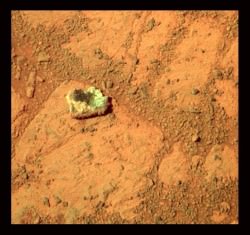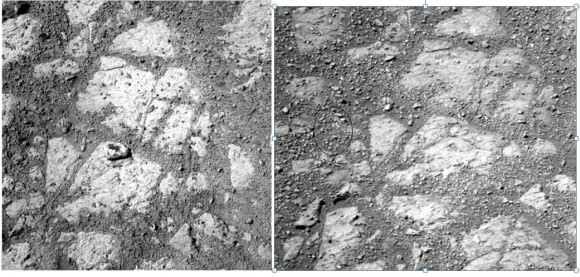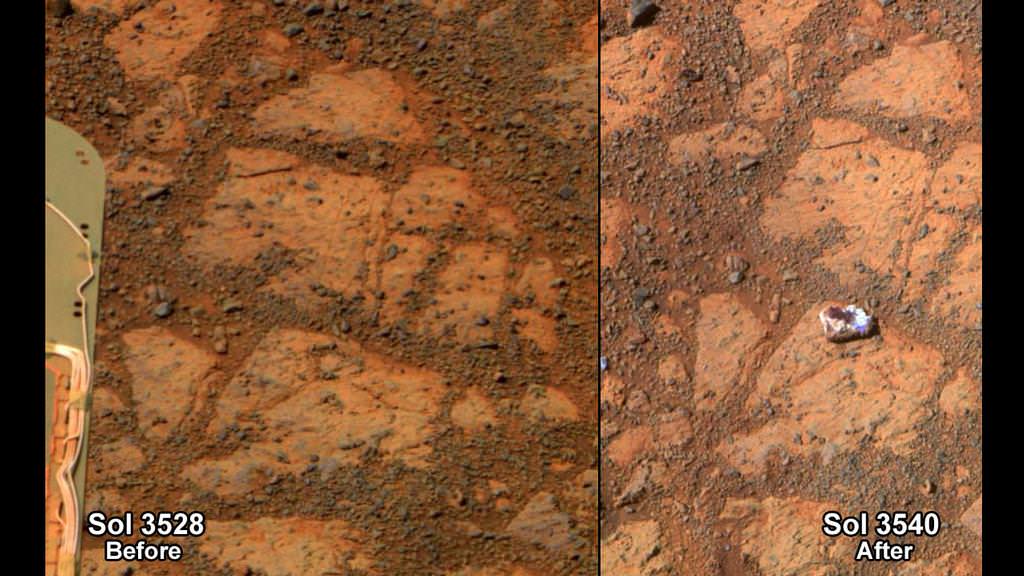Hoo boy. Just mention the word “mystery” in conjunction with the planet Mars and all sorts of folks come out of the woodwork. Some start talking about silicon-based alien life forms or Mars-based reptiles or projectiles being tossed by little green men. The latest is that there’s an exotic mushroom on Mars, and this idea has sparked a lawsuit against NASA.
This all started when a strange rock suddenly appeared in photos from the Opportunity rover in a spot where photos taken just 12 sols (Mars days) earlier showed no rock. Mission principal investigator Steve Squyres talked about it during the recent 10-year anniversary celebration for the rover.
“It appeared,” Squyres said during the event. “It just plain appeared and we haven’t driven over that spot.”
They’ve named the rock “Pinnacle Island,” and Squyres and the Mars Exploration Rover team think the most likely scenario is that the rover actually dislodged the rock with its wheels and flicked it to a new spot as the rover was turning. “We had driven a meter or two away from here and somehow maybe one of the wheels managed spit it out of the ground,” Squyres said. “That’s the more likely theory.”

Another idea is that the rock is a piece of ejecta – a piece of rock which plunked down near the rover after being blasted out of the ground by a nearby meteoroid impact.
An idea favored by our readers here on Universe Today is that it possibly was a meteorite, dropping in from space and landing near the rover. Another thought is that since Opportunity is currently at Solander Point, a mountain of sorts, the rock may have rolled down to its new spot from a higher outcrop.
We checked in with Steve Squyres to see if there any new possibilities and he said the team thoughts on the rock’s appearance are the same as they were last week.
“We think the most likely hypothesis is that it was dislodged by the rover wheels from a location that may currently be obscured by the solar arrays,” he said via email.
Squyres described the rock as “white around the outside, in the middle there’s low spot that is dark red. It looks like a jelly donut,” and said it’s like nothing they’ve ever seen before on Mars.
Then things got weird. We received an email this week from neurologist and self-proclaimed astrobiologist Dr. Rhawn Joseph, of the Journal of Cosmology fame who we’ve previously written about.
He has filed a lawsuit in the US District Court Northern District of California claiming the white rock is biological in nature and is seeking an order forcing NASA, Administrator Charles Bolden, and others including Squyres to “examine a biological specimen on Mars” and that NASA is failing to investigate the rock thoroughly enough.
Joseph is petitioning the Federal Court for a writ of mandamus to “compel and order” NASA to “perform a public, scientific, and statutory duty which is to closely photograph and thoroughly scientifically examine and investigate a putative biological organism which was identified (and thus discovered) by Petitioner.”
From the lawsuit:
“Petitioner immediately recognized that bowl-shaped structure, hereafter referred to as Sol 3540,resembling a mushroom-like fungus, a composite organism consisting of colonies of lichen and cyanobacteria, and which on Earth is known as Apothecium.”
“When examined by Petitioner the same structure in miniature was clearly visible upon magnification and appears to have just germinated from spores.”
(Yeah, we’ve discussed previously the problems with zooming in on rocks on Mars – people start seeing crazy things).
For one thing, this is a rock. A rock. Squyres has said Pinnacle Island is very high in sulfur and magnesium, with twice as much manganese as anything else they’ve seen on Mars.
Second, the rover team is already throwing everything they’ve got at this rock.
“We are as we speak situated with the rover, with its instruments, making measurements on this rock. We’ve taken pictures of both the donut part and the jelly part,” Squyres said during the 10-year anniversary event.
Third, Joseph is not the “discoverer” of this rock. The MER team is and they’ve given full disclosure, talking frequently about the rock and posting all the images they’ve taken of the rock available for anyone to peruse.
So, where did this rock come from?
Of course, the folks from UnmannedSpaceflight.com have been discussing this rock before anyone else, since December when the images were first downloaded from the rover and put on NASA’s rover raw images website.
They’ve offered a few ideas, but this image from sol 3544 pointed out by “marsophile” on the forum might be the most compelling:

There appears to hole in the ground where a rock may have previously been.
Another set of images submitted by Universe Today reader Yuksel Kenaroglu highlights a possible location where the rock may have come from, but changes in lighting might just be making things look different in the two images:

Joseph said he wants “A) 100 high resolution close-up infocus photos of the specimen identified in Sol 3540, at various angles, from all sides, and from above down into the “bowl” of the specimen, and under appropriate lighting conditions which minimize glare. B) Take a minimum of 24 microscopic in-focus images of the exterior, lip, walls, and interior of the specimen under appropriate lighting conditions. C) NASA, and the rover team must make public and supply Petitioner with all high resolution photos and images of that specimen as demanded in A and B.”
By the way, You can see all the images anytime here,
from the microscopic imager and all other eight cameras on the rover
Surely, Squyres and the MER team would like nothing better than to solve the mystery of how this rock appeared and just like the Mars flower, and the piece of plastic there’s very little likelihood that biology plays any role in this rock an how it suddenly appeared.
If you want to see Joseph’s lawsuit, PopSci has it online.


Haha! Fantastic article. After all the nonsense that’s gone around the net, finally someone brings a little scientific method into the mix.
I think the air would be to dry (near vacuum dry) for any kind of Life (Lichen) to be so generous about creating a mushroom cap. Not to mention that the odds of 1 singel spore finding a healthy spot to survive are less than the amount of spores a mushroom would produce.
Even stratospheric borne Earth spores have a hospitable place as soon as they finally drop back down to Earth.
I find the article unnecessarily dismissive
For example Starting with …Hooy boy was ok because there is quite a bit of crazy conjecture out there about NASA mars images. But then the article descends into a snarky tone about the petition by Dr. Rhawn Joseph.. With:
… We received an email this week from neurologist and self-proclaimed astrobiologist Dr. Rhawn Joseph, of the Journal of Cosmology fame who we’ve previously written about…
That seems to be getting a little personal and seems quite condescending (I understand the man’s ideas are unconventional but he is nonetheless a space exploration advocate so why this tone?)….
and then:
…For one thing, this is a rock. A rock. Squyres has said Pinnacle Island is very high in sulfur and magnesium, with twice as much manganese as anything else they’ve seen on Mars….
Hammers a point which is a bit contradictory ?
And then:
…You can see all the images here. (link provided)
I clicked the link and viewed the microscopic (only closeup) images provided for sol 3540 which is the only relevant Mars Sol date mentioned in this article. There is a grand total of 2 closeup images of the jelly donut rock. (2 x 4 images – each 4 images are identical excepting focus differences).
So Mr Joseph’s petition seems very reasonable in light of this. We have just been told by the NASA project lead: …Pinnacle Island is very high in sulfur and magnesium, with twice as much manganese as anything else they’ve seen on Mars…
In light of this and the seemingly sparse amount of published details on this specimen, Mr Joseph’s petition quite seems reasonable.
This article does not.
I do appreciate and respect the great articles you write Nancy and realise that almost single handedly you help sustain the great content on this site. My intention is just to ask a little more fairness towards people who’s hearts seem to be in the right place as it seems Mr Joseph is a passionate space exploration advocate, albeit perhaps quite unconventional and perhaps not academically titled.
Yikes. Look at this:
“The refusal to take close up photos from various angles, the refusal to take microscopic images of the specimen, the refusal to release high resolution photos, is inexplicable, recklessly negligent, and bizarre. Any intelligent adult, adolescent, child, chimpanzee, monkey, dog, or rodent with even a modicum of curiosity, would approach, investigate and closely examine a bowl-shaped structure which appears just a few feet in front of them when 12 days earlier they hadn’t noticed it. But not NASA and its rover team who have refused to take even a single close up photo.”
After reading that, I find it hard to pay attention to Mr. Joseph’s statements. He claims that a rodent “would approach, investigate and closely examine a bowl-shaped structure”. Wow.
Obviously him speaking in frustration – but nonetheless paints a bad picture. Based on that, it’s clear why his comments would be dismissed. What is not clear is why someone would stick up for him.
Agreed. After some further digging, I confirmed a bit more of what Nancy said in the article. Mr Joseph it would appear got a Juris Doctorate (a Ph.d in Law) and wrote in the Journal of Cosmology. Other than I can find no other scientific credentials on the Interwebs.
I also hadn’t read his petition. Ouch. If you are reading this Nancy, that petition excerpt Lucky posted would have helped me understand the reason for the tone of your article.
Nancy I rushed to judgement on your article. Apologies.
In response to Lucky, I consider any advocate of space exploration a likeminded human being and will stick up for them (as long as they maintain respect for others).
I’m with you there. Power to the cosmos.
The object resembles a jelly donut? looks like they never eat donuts at NASA. I wrote here, a few days ago, though only half seriously, that for me it is a “flower, a Martian flower and that Mars is blooming for us” (sorry I used a wrong verb in that opportunity, I apologize for my bad English). Now it seems that other people have the same idea. There is one safe way of knowing whether this is a rock, albeit a strange one, or an organic object: just leave it alone and check it periodically. If meteorite, a rolled down rock or whatever else of mineral origin, it will remain there for ever. If organic, it will quickly wither. So it would be better that NASA takes and releases some better close up pictures of the object, before this could happen. Even if this has to be fought in Court.
Calling RCH!
I would like to point out what I believe to be an inaccuracy in this article:
quoting: …Squyres has said Pinnacle Island is very high in sulfur and magnesium, with twice as much manganese as anything else they’ve seen on Mars….
According to an article from space.com on January 21, 2014 04:35pm ET:
“It looks like a jelly donut,” said Steve Squyres, the rover’s lead scientist at Cornell University in Ithaca, N.Y., during a recent NASA event marking Opportunity’s 10th year on Mars. “And it appeared, it just plain appeared, at that spot and we haven’t driven over that spot.”
A closer look at the rock using Opportunity’s robotic arm-mounted instruments revealed even more surprises.
“It’s like nothing we ever seen before. It’s very high in sulfur, very high in magnesium, it has twice as much manganese than anything we’ve seen on Mars,” Squyres said with excitement in last week’s Jan. 16 event. “I don’t know what any of this means. We’re completely confused, we’re having a wonderful time.”
So Squyres was talking about usually high sulfur and magnesium in the ‘jelly donut’ ‘rock’ and not Pinnacle Island as asserted in this article.
Also Squyres own words: “… And it appeared, it just plain appeared, at that spot and we haven’t driven over that spot.”
Put doubt into the theories circulating at NASA and reinforced by this article (by implication) that the rover wheels dislodged a ‘rock,’ referring to the caption: ‘showing possible location of where the ‘Jelly Donut’ rock came from…’
For now I am placing the ‘rock’ in single quotes because I believe proper scientific rigor and careful investigation has not yet been applied to form any conclusion.
So I am back to my original position of supporting Mr Joseph and the Petition and wondering if this article is fair, accurate and balanced.
The name of the jelly donut rock *is* Pinnacle Island. The location the rover is at is Solander Point.
Thanks Nancy. I stand corrected. Pinnacle Island is quite a confusing name for a rock though…
As an interesting side note, it has been established in studies that magnesium sulfate is one of the best fertilizers for spore based organisms, with sulfur being the most essential element for the growth of fungi.
I find it disturbing when scientific minds are too quick to dismiss those who question new findings in big ways. A key part of the scientific process involves another party questioning the finding to the converse, or at least some variation thereof. I think this push and pull of question and answer, in even the most large-gap ways, is what can drive deep and detailed analysis and ultimately would serve the whole scientific community and world to the better. It’s sad for me to see someone going from reading ‘we have never seen anything like this on Mars before’ and have a someone jump straight to ‘it’s juuust a rooock!!’ or even ‘this is a mushroommm!!’. Either way, you are both jumping to premature conclusions. It just seems a little much to just “quackify” someone who strongly questions a new finding!!! Think about it. I commend this guy for his strong questioning!!!
Well, this is Mars we’re talking about, and that planet has quite a history of whacky “discoveries” going back at least to the 19th century. Percival Lowell was sure that there were canals on Mars, for instance. So some eye-rolling is to be expected at this latest claim.
Rhawn Joseph of Journal of Cosmology fame? LOL. Here’s this “scientist’s” take on PZ Meyers: http://scienceblogs.com/pharyngula/2011/07/20/professional-science-journalis/
With his past history of lawsuits against NASA I think it’s apparent Mr Joseph has some screws loose. Can you imagine the chaos that would ensue if anyone who saw something unusual on images from Curiosity, Opportunity, MRO, LRO, MESSENGER or Cassini could file suit against NASA demanding an investigation of their claims? Richard Hoagland would have a field day!
Agreed – He is quite unconventional and I also agree with Phil Plat (Bad Astrnomy) and others who have pointed out many poorly documented and methodically unsound findings made in the Journal of Cosmology.
Still, I think NASA and a large part of the community have rushed to the conclusion of ‘its just a rock’ when in Squyres own words: “It’s like nothing we ever seen before. It’s very high in sulfur, very high in magnesium, it has twice as much manganese than anything we’ve seen on Mars… I don’t know what any of this means. We’re completely confused, we’re having a wonderful time.”
Wouldn’t this warrant a separate dedicated investigation and corresponding press release to the public with detailed analysis and close-up photos? More than just the two (semi) close-up images supplied for sol 3540???
Personally I haven’t reached any conclusion on the object as I do not yet have enough information at hand to form a conclusion (only the theories of Squyres presented that maybe the rover track flipped the ‘rock’ downhill whilst turning). The logical inconsistency of not thoroughly investigating such an admittedly unique specimen freshly exposed only adds fuel to the fires of those asserting wild claims.
Why do people always seem to dismiss someone just because they don’t have the degree that others think they should have? I know plenty of people (who have never even gone to college) that are smarter than 80% that have degree’s!
It looks like a blob of melted metal to me.
[img]http://d1jqu7g1y74ds1.cloudfront.net/wp-content/uploads/2014/01/pia17761_SS4-PinnacleIsland_br2.jpg[/img]
“Martian jelly donut rock”
[img]http://tricivenola.files.wordpress.com/2012/10/melted-lead.jpg?w=584&h=438[/img]
blob of melted lead
Looks like I can’t post pictures on here, but if you look at
http://tricivenola.files.wordpress.com/2012/10/melted-lead.jpg?w=584&h=438
you will see that the “Martian jelly donut rock”
http://d1jqu7g1y74ds1.cloudfront.net/wp-content/uploads/2014/01/pia17761_SS4-PinnacleIsland_br2.jpg
looks just like a blob of solidified molten lead or solder.